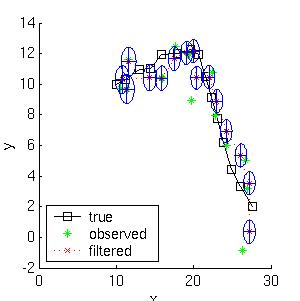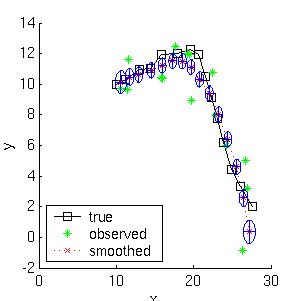原文地址:http://www.cs.ubc.ca/~murphyk/Software/Kalman/kalman.html
Written by Kevin Murphy, 1998.
Last updated: 7 June 2004.
This toolbox supports filtering, smoothing and parameter estimation (using EM) for Linear Dynamical Systems.
- Download toolbox
- What is a Kalman filter?
- Example of Kalman filtering and smoothing for tracking
- What about non-linear and non-Gaussian systems?
- Other software for Kalman filtering, etc.
- Recommended reading
Functions
- kalman_filter
- kalman_smoother - implements the RTS equations
- learn_kalman - finds maximum likelihood estimates of the parameters using EM
- sample_lds - generate random samples
- AR_to_SS - convert Auto Regressive model of order k to State Space form
- SS_to_AR
- learn_AR - finds maximum likelihood estimates of the parameters using least squares
What is a Kalman filter?
For an excellent web site, see Welch/Bishop's KF page.
For a brief intro, read on...
A Linear Dynamical System is a partially observed stochastic process with linear dynamics and linear observations, both subject to Gaussian noise. It can be defined as follows, where X(t) is the hidden state at
time t, and Y(t) is the observation.
x(t+1) = F*x(t) + w(t), w ~ N(0, Q), x(0) ~ N(X(0), V(0)) y(t) = H*x(t) + v(t), v ~ N(0, R)
The Kalman filter is an algorithm for performing filtering on this model, i.e., computing P(X(t) | Y(1), ..., Y(t)).
The Rauch-Tung-Striebel (RTS) algorithm performs fixed-interval offline smoothing, i.e., computing P(X(t) | Y(1), ..., Y(T)), for t <= T.
Example of Kalman filtering
[ x1(t) ] = [1 0 1 0] [ x1(t-1) ] + [ wx1 ] [ x2(t) ] [0 1 0 1] [ x2(t-1) ] [ wx2 ] [ dx1(t) ] [0 0 1 0] [ dx1(t-1) ] [ wdx1 ] [ dx2(t) ] [0 0 0 1] [ dx2(t-1) ] [ wdx2 ]
We assume we only observe the position of the particle.
[ y1(t) ] = [1 0 0 0] [ x1(t) ] + [ vx1 ]
[ y2(t) ] [0 1 0 0] [ x2(t) ] [ vx2 ]
[ dx1(t) ]
[ dx2(t) ]
Suppose we start out at position (10,10) moving to the right with velocity (1,0). We sampled a random trajectory of length 15. Below we show the filtered and smoothed trajectories.
 |
 |
The mean squared error of the filtered estimate is 4.9; for the smoothed estimate it is 3.2. Not only is the smoothed estimate better, but we know that it is better, as illustrated by the smaller uncertainty ellipses; this can help in e.g., data association
problems. Note how the smoothed ellipses are larger at the ends, because these points have seen less data. Also, note how rapidly the filtered ellipses reach their steady-state (Ricatti) values. (Click here to
see the code used to generate this picture, which illustrates how easy it is to use the toolkit.)
What about non-linear and non-Gaussian systems?
For non-linear systems, I highly recommend the ReBEL Matlab
package, which implements the extended Kalman filter, the unscented Kalman filter, etc. (See Unscented filtering and nonlinear estimation,
S Julier and J Uhlmann, Proc. IEEE, 92(3), 401-422, 2004. Also, a small correction.)
For systems with non-Gaussian noise, I recommend Particle filtering (PF), which is a popular sequential Monte Carlo technique. See also this discussion
on pros/cons of particle filters. and the following tutorial: M. Arulampalam, S. Maskell, N. Gordon, T. Clapp, "A Tutorial on Particle Filters for Online Nonlinear/Non-Gaussian Bayesian Tracking," IEEE
Transactions on Signal Processing, Volume 50, Number 2, February 2002, pp 174-189 (pdf cached here The EKF can be used as a proposal distribution for a PF. This method is better
than either one alone. The Unscented Particle Filter, by R van der Merwe, A Doucet, JFG de Freitas and E Wan, May 2000.Matlab software for
the UPF is also available.
Gatsby reading group on nonlinear dynamical systems
Other packages for Kalman filtering and state-space models
- SSPIR package in R. The system identification toolbox from the Mathworks implements many classical algorithms.
- ARfit is an excellent package for autoregressive models.
- Zoubin Ghahramani has matlab code for EM in LDS's which is similar to mine, but is partially written in C.
- KBF, an implementation of the Kalman filter-smoother in Omatrix, a (supposedly faster) version of matlab.
- Le Sage's econometrics toolbox, contains lots of excellent matlab time series modelling functions
- Econometric Links Econometrics Journal. Most of the software is either commercial or written in Gauss, which is similar to Matlab.
- SSF pack is a set of C routines for state-space filtering.
- Stamp is a commercial package for structural time series analysis. Statistical Time Series Analysis Toolbox O
matrix Statistical Time Series Analysis Toolbox
Recommended reading
- Welch & Bishop, Kalman filter web page, the best place to start.
- T. Minka, "From HMMs to LDSs", tech report.
- T. Minka, Bayesian inference in dynamic models -- an overview , tech report, 2002
- K. Murphy. "Filtering, Smoothing, and the Junction Tree Algorithm",. tech. report, 1998.
- Roweis, S. and Ghahramani, Z. (1999) A Unifying Review of Linear Gaussian Models Neural Computation 11(2):305--345.
- M. Arulampalam, S. Maskell, N. Gordon, T. Clapp, "A Tutorial on Particle Filters for Online Nonlinear/Non-Gaussian Bayesian Tracking," IEEE Transactions on Signal Processing, Volume 50, Number 2, February
2002, pp 174-189. - A. Doucet, N. de Freitas and N.J. Gordon, "Sequential Monte Carlo Methods in Practice", Springer-Verlag, 2000